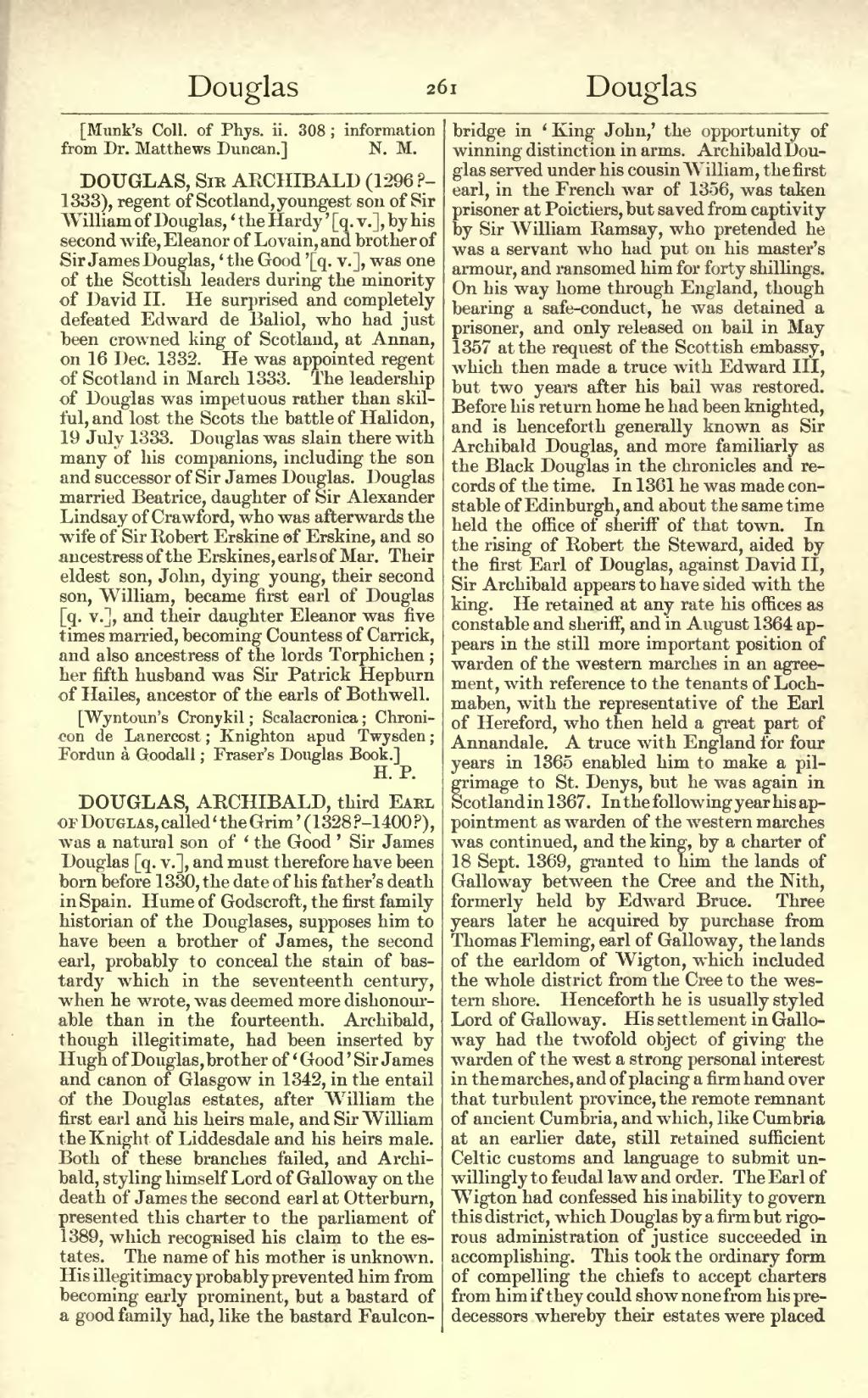[Munk's Coll. of Phys. ii. 308; information from Dr. Matthews Duncan.]
DOUGLAS, Sir ARCHIBALD (1296?–1333), regent of Scotland, youngest son of Sir William of Douglas, ‘the Hardy’ [q. v.], by his second wife, Eleanor of Lovain, and brother of Sir James Douglas, ‘the Good’ [q. v.], was one of the Scottish leaders during the minority of David II. He surprised and completely defeated Edward de Baliol, who had just been crowned king of Scotland, at Annan, on 16 Dec. 1332. He was appointed regent of Scotland in March 1333. The leadership of Douglas was impetuous rather than skilful, and lost the Scots the battle of Halidon, 19 July 1333. Douglas was slain there with many of his companions, including the son and successor of Sir James Douglas. Douglas married Beatrice, daughter of Sir Alexander Lindsay of Crawford, who was afterwards the wife of Sir Robert Erskine of Erskine, and so ancestress of the Erskines, earls of Mar. Their eldest son, John, dying young, their second son, William, became first earl of Douglas [q. v.], and their daughter Eleanor was five times married, becoming Countess of Carrick, and also ancestress of the lords Torphichen; her fifth husband was Sir Patrick Hepburn of Hailes, ancestor of the earls of Bothwell.
[Wyntoun's Cronykil; Scalacronica; Chronicon de Lanercost; Knighton apud Twysden; Fordun à Goodall; Fraser's Douglas Book.]
DOUGLAS, ARCHIBALD, third Earl of Douglas, called ‘the Grim’ (1328?–1400?), was a natural son of ‘the Good’ Sir James Douglas [q. v.], and must therefore have been born before 1330, the date of his father's death in Spain. Hume of Godscroft, the first family historian of the Douglases, supposes him to have been a brother of James, the second earl, probably to conceal the stain of bastardy which in the seventeenth century, when he wrote, was deemed more dishonourable than in the fourteenth. Archibald, though illegitimate, had been inserted by Hugh of Douglas, brother of ‘Good’ Sir James and canon of Glasgow in 1342, in the entail of the Douglas estates, after William the first earl and his heirs male, and Sir William the Knight of Liddesdale and his heirs male. Both of these branches failed, and Archibald, styling himself Lord of Galloway on the death of James the second earl at Otterburn, presented this charter to the parliament of 1389, which recognised his claim to the estates. The name of his mother is unknown. His illegitimacy probably prevented him from becoming early prominent, but a bastard of a good family had, like the bastard Faulconbridge in ‘King John,’ the opportunity of winning distinction in arms. Archibald Douglas served under his cousin William, the first earl, in the French war of 1356, was taken prisoner at Poictiers, but saved from captivity by Sir William Ramsay, who pretended he was a servant who had put on his master's armour, and ransomed him for forty shillings. On his way home through England, though bearing a safe-conduct, he was detained a prisoner, and only released on bail in May 1357 at the request of the Scottish embassy, which then made a truce with Edward III, but two years after his bail was restored. Before his return home he had been knighted, and is henceforth generally known as Sir Archibald Douglas, and more familiarly as the Black Douglas in the chronicles and records of the time. In 1361 he was made constable of Edinburgh, and about the same time held the office of sheriff of that town. In the rising of Robert the Steward, aided by the first Earl of Douglas, against David II, Sir Archibald appears to have sided with the king. He retained at any rate his offices as constable and sheriff, and in August 1364 appears in the still more important position of warden of the western marches in an agreement, with reference to the tenants of Lochmaben, with the representative of the Earl of Hereford, who then held a great part of Annandale. A truce with England for four years in 1365 enabled him to make a pilgrimage to St. Denys, but he was again in Scotland in 1367. In the following year his appointment as warden of the western marches was continued, and the king, by a charter of 18 Sept. 1369, granted to him the lands of Galloway between the Cree and the Nith, formerly held by Edward Bruce. Three years later he acquired by purchase from Thomas Fleming, earl of Galloway, the lands of the earldom of Wigton, which included the whole district from the Cree to the western shore. Henceforth he is usually styled Lord of Galloway. His settlement in Galloway had the twofold object of giving the warden of the west a strong personal interest in the marches, and of placing a firm handover that turbulent province, the remote remnant of ancient Cumbria, and which, like Cumbria at an earlier date, still retained sufficient Celtic customs and language to submit unwillingly to feudal law and order. The Earl of Wigton had confessed his inability to govern this district, which Douglas by a firm but rigorous administration of justice succeeded in accomplishing. This took the ordinary form of compelling the chiefs to accept charters from him if they could show none from his predecessors whereby their estates were placed
